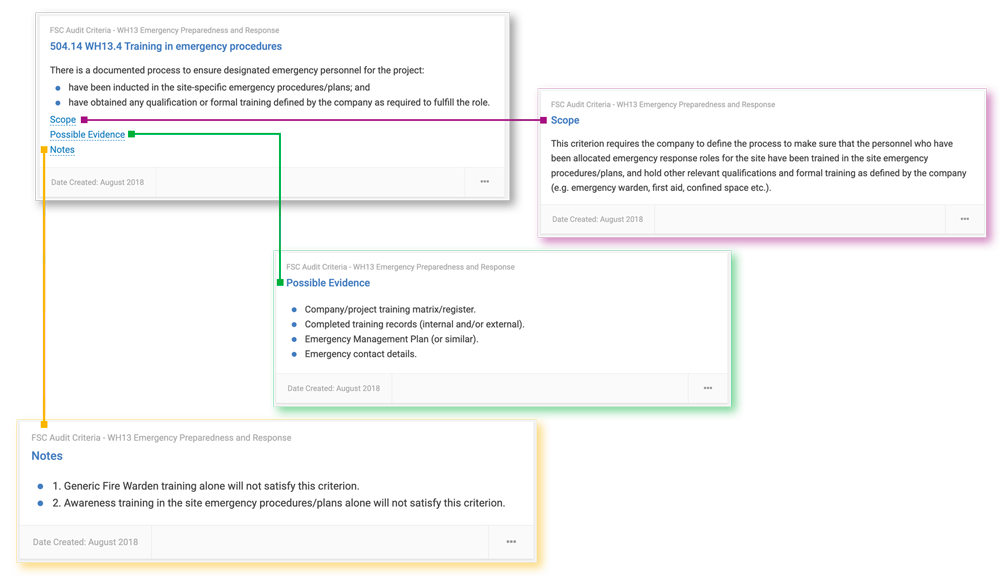Achieving a smooth path to WHS Accreditation with HSE LawGuides
Ensuring the highest standards of workplace health and safety (WHS) is critical in the construction industry. The Federal Safety Commissioner (FSC) Work Health and Safety Accreditation Scheme (the Scheme) sets a benchmark for best practices, helping companies demonstrate their commitment to a safe working environment.
A crucial component of this process is the FSC Audit Criteria Guidelines, which provide a structured approach to meeting audit expectations.
Our online directory, HSE LawGuides provides summaries of the FSC Audit Criteria Guidelines to assist businesses in understanding and meeting the criteria for accreditation.
In this article, we provide background on the Scheme accreditation, including its requirements, application process, ongoing compliance and reaccreditation, and detail the role of the FSC Audit Criteria Guidelines and HSE LawGuides.

Accreditation Requirements
To achieve accreditation from the FSC, a builder must have a work health and safety management system that meets the FSC Audit Criteria and demonstrates its effective implementation on-site.
To gain accreditation, applicants must:
- demonstrate effective management of construction hazards and high-risk activities
- have a strong workplace safety record
- achieve consistently good on-site audit results, with a focus on:
- senior management commitment to WHS
- integration of safe design principles
- effective WHS consultation and communication
- strong subcontractor WHS management
- project-wide performance measurement
- WHS training and competency in risk management

How to Apply for Accreditation
Gaining accreditation under the Scheme involves a three-stage process.
Stage one
Companies must submit an application online through FSC Online, providing details on their WHS performance, safety management system, and current projects. A declaration confirming compliance with the National Construction Code must also be signed.
Stage two
A Systems Validation audit is conducted by an independent Federal Safety Officer (FSO) to assess the company’s WHS Management System against Scheme criteria. This audit, which can be virtual or in-person, identifies any gaps in compliance. A detailed report is provided within 10 business days, outlining areas that meet requirements and those needing improvement.
Stage three
If successful, the company progresses to an on-site audit at a project where it is the principal contractor. The FSO evaluates the practical implementation of WHS procedures, verifying compliance through documentary evidence. Following this audit, another report is issued, detailing any non-conformances.
The final accreditation decision is made by the FSC based on the audit findings. The report is usually provided 10 days after the audit.

Ongoing Auditing and Compliance
Accredited companies are subject to regular on-site audits to ensure they maintain the highest safety standards in line with the WHS Accreditation Scheme. These audits verify that companies are correctly implementing their documented WHS systems and processes and that they continue to meet the Scheme’s requirements.
Audits are conducted against the WHS Accreditation Scheme Audit Criteria, covering three key criteria: WHS management systems, focus points, and hazards. If non-conformances are identified, companies may need to undergo a follow-up audit to confirm that corrective actions have been implemented on-site.
Audit durations vary, typically lasting one to two days, depending on the scope of assessment. Following an audit, companies receive a detailed report outlining any issues, along with an action plan requirement to address them.
Reaccreditation
Under the WHS Accreditation Scheme, companies receive initial accreditation for up to three years.
To maintain accreditation, companies must reapply at the end of this period. Those successfully reaccredited may receive accreditation for up to six years, depending on their compliance history with the Scheme requirements.

Benefits of Accreditation
Accreditation under the WHS Accreditation Scheme offers key benefits for construction companies, including:
- Enhanced Safety Performance: Accredited companies have demonstrated improvements in safety metrics, with trends showing reductions in both Medically Treated Injury Frequency Rates and Lost Time Injury Frequency Rates.
- Financial Savings: Improved safety performance leads to fewer lost time injuries, resulting in reduced work stoppages and associated costs. Additionally, accredited companies tend to pay lower workers’ compensation premium rates over time.
- Eligibility for Government Projects: Accreditation enables companies to tender for Commonwealth-funded building projects. Moreover, it automatically satisfies prequalification WHS requirements in several states and territories, including the Australian Capital Territory, New South Wales, Northern Territory, Queensland, South Australia, Victoria, and Western Australia.
- Industry Recognition: Achieving accreditation signals to the industry and potential clients that a company upholds best practice workplace health and safety systems and practices on its sites.
According to a 2023 survey, 99% of accredited companies reported improved safety, and 94% saw value for money.

FSC Audit Criteria Guidelines
The FSC Audit Criteria Guidelines helps businesses navigate the WHS Accreditation Scheme by providing clear explanations of the audit criteria, their intent and the types of evidence required to demonstrate compliance.
The guidelines are designed to assist businesses in preparing for accreditation or reaccreditation by outlining expectations and offering practical guidance on meeting WHS requirements.
By simplifying the audit process, they help reduce compliance burdens while ensuring companies uphold the highest safety standards in the construction industry.
FSC Audit Criteria Guidelines summarised in HSE LawGuides
The summaries of the FSC Audit Criteria Guidelines aid businesses in the preparation of WHS accreditation and reaccreditation by including:
- A comprehensive overview of the Scheme requirements
- A link to the scope: the intent behind the criterion and guidance for interpretation
- A link to possible evidence: examples of acceptable evidence that demonstrate conformance with the criterion
- A link to associated notes: the types of evidence that do not meet the criterion
The online directory also offers the ability to run preliminary audits by exporting checklists of the FSC Audit Criteria Guideline summaries.
An example of an FSC Audit Criteria summary and its linked information

If you would like to see how HSE LawGuides can assist you in achieving WHS Accreditation, then sign up for a free trial or get in contact.
References
- Department of Employment and Workplace Relations Publication: FSC Audit Criteria Guidelines: The FSC Audit Criteria Explained
- Department of Employment and Workplace Relations Webpage: Auditing
- Department of Employment and Workplace Relations Webpage: How to Apply for Accreditation
- Department of Employment and Workplace Relations Webpage: Reaccreditation
- Department of Employment and Workplace Relations Webpage: Scheme Accreditation
- Department of Employment and Workplace Relations Webpage: What is Accreditation?
- Department of Employment and Workplace Relations Webpage: Why Should I Get Accredited?